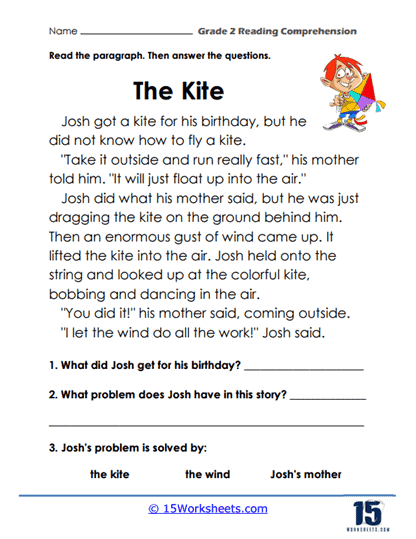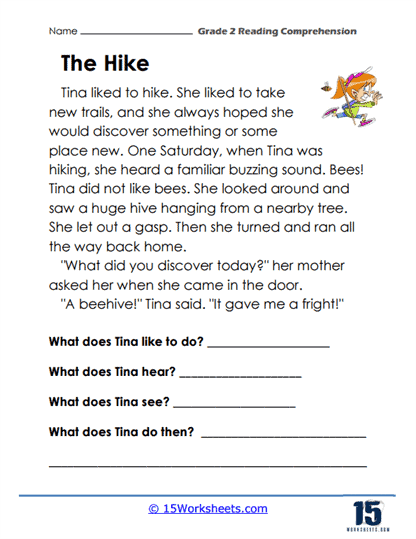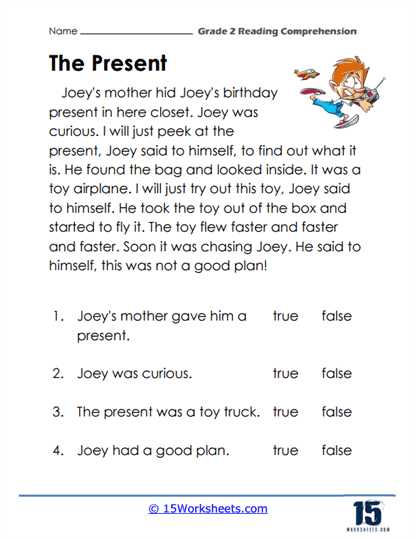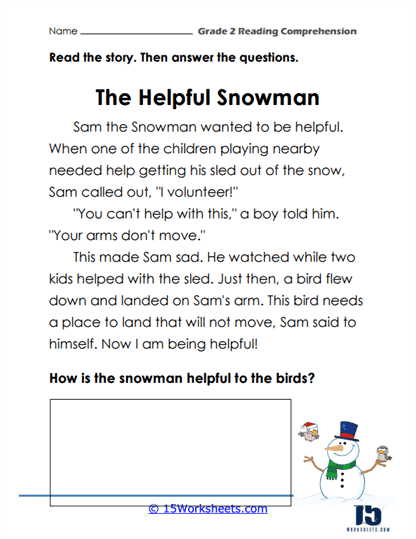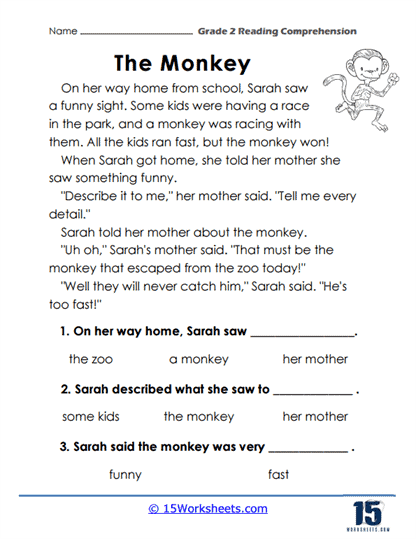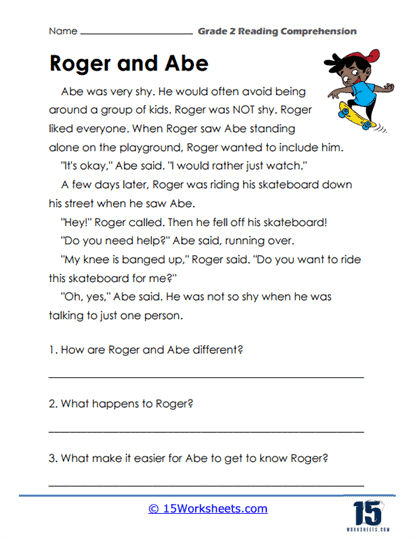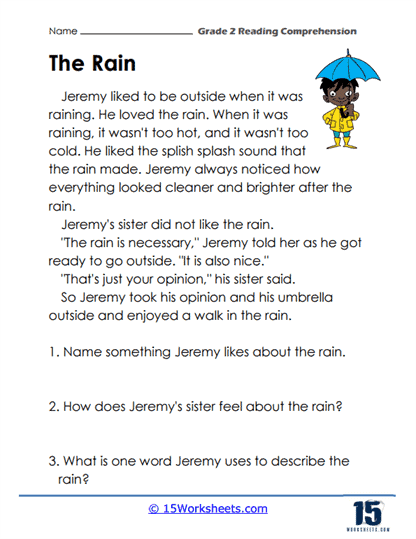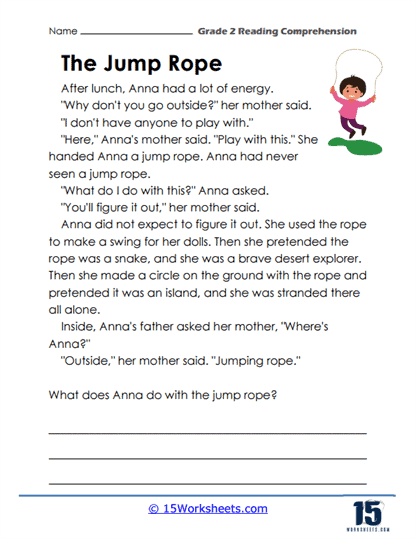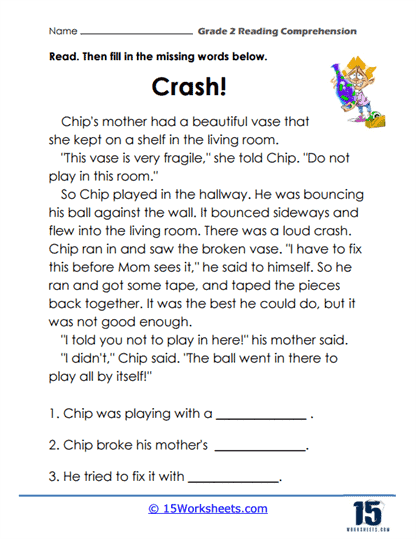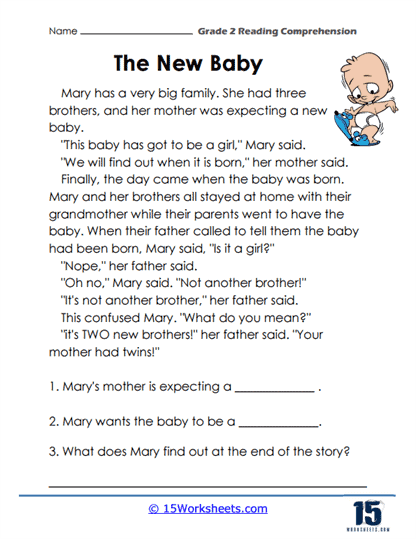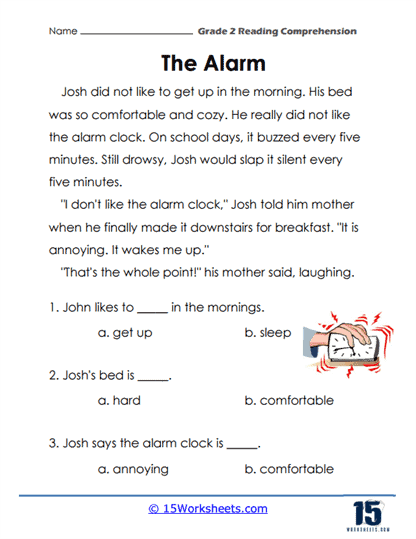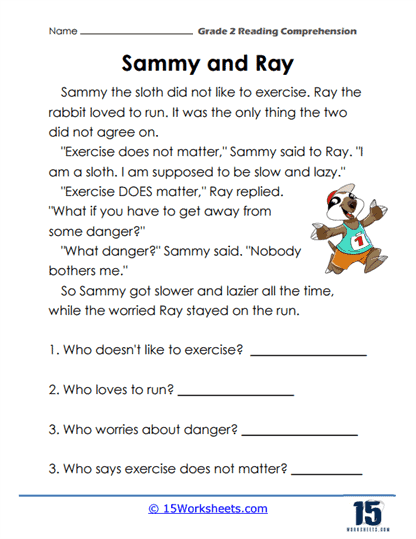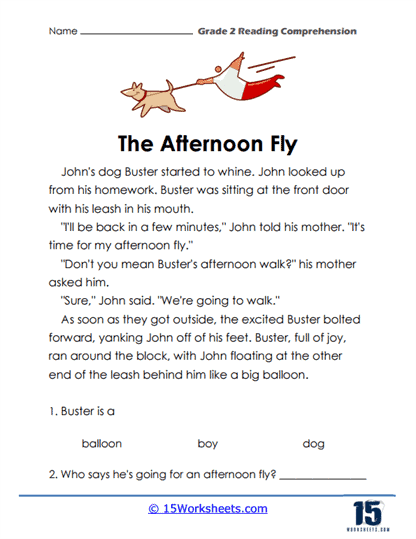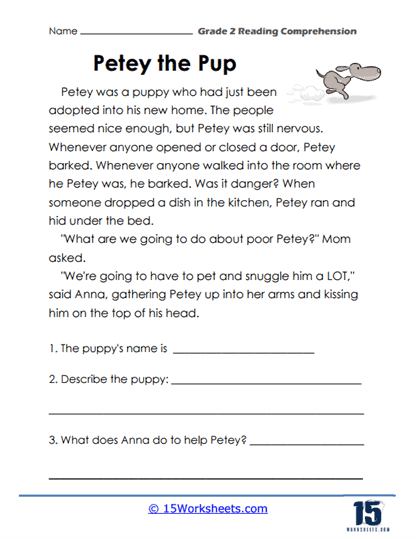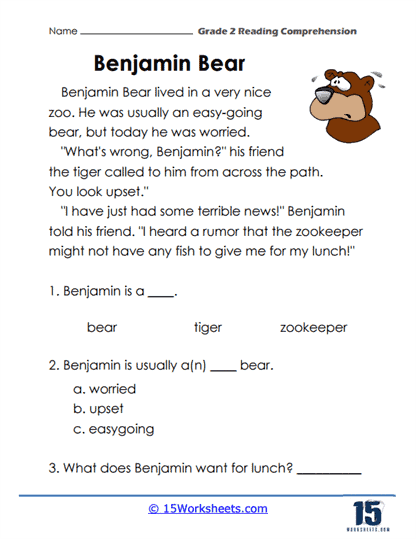Grade 2 Reading Comprehension Worksheets
All About These 15 Worksheets
These worksheets will help enhance the reading and language arts skills of young students, typically around 7 to 8 years old. At this level, students are beginning to transition from learning to read to reading to learn. These worksheets help students improve their ability to understand written material, make connections, and critically think about texts. The worksheets usually feature short passages or stories followed by questions that test a student’s comprehension of the material. They aim to develop essential skills like recalling information, recognizing vocabulary, and identifying key details within a passage.
These worksheets are extremely beneficial for both students and teachers. For students, they offer structured practice, allowing them to engage with different types of text—narrative, informative, or descriptive. This variety builds a foundation in reading comprehension, vocabulary, and grammar. For teachers, they provide a measurable way to assess a student’s progress in reading and language arts. Regular practice with these worksheets can help students become more confident readers by developing their ability to think critically about what they read and communicate their understanding effectively.
A typical worksheet includes various types of exercises and problems. One common exercise is multiple-choice questions, which ask students to choose the correct answer based on information directly from the text. These questions often target key comprehension skills like identifying the main idea or understanding the meaning of a word in context. Other worksheets may include “fill-in-the-blank” exercises, where students must recall specific details or sequence events from the story.
In addition to direct recall, some worksheets challenge students to make inferences, encouraging them to read between the lines and draw conclusions based on clues in the text. Open-ended questions are another important feature, asking students to provide written responses that require deeper reflection, personal connections, or summarization of the text. Sequencing activities, where students arrange events from a story in the correct order, are also common. All of these activities help to reinforce literacy skills by engaging students in thoughtful reading and comprehension exercises.
The collection of worksheets focuses on developing a range of fundamental reading skills for young students, primarily targeting comprehension, vocabulary, and critical thinking. These worksheets use short, engaging stories and simple questions that encourage students to practice essential reading comprehension techniques.
Each worksheet presents a brief narrative followed by a series of questions designed to check understanding. These questions often focus on recalling specific details from the text (e.g., “What did Josh get for his birthday?” in The Kite), inferring meaning (e.g., “What does Josh do to solve his problem?”), and drawing conclusions (e.g., “How is the snowman helpful to the birds?” in The Helpful Snowman). This type of exercise helps students focus on literal comprehension while also building the skill of making inferences based on context clues.
These worksheets cover various comprehension skills, including identifying main ideas, sequencing events, and understanding cause and effect. For example, in The Hike, students are asked to recount what Tina hears, sees, and does, encouraging them to piece together events in sequence. The questions in these exercises often require students to think about character actions and motivations, fostering empathy and deeper comprehension of the text.
The true or false questions, such as those found in The Present, challenge students to evaluate the accuracy of statements based on their reading. This promotes critical thinking and attention to detail. Similarly, vocabulary-building exercises are incorporated into some worksheets, with students identifying key words in context or filling in blanks, as seen in Crash!.
Overall, these worksheets help students practice reading skills in a structured and enjoyable way, improving their ability to understand and analyze simple narratives. They help second-grade students practice reading fluency, recall information, understand sequences, and make basic inferences-all essential skills as they develop stronger reading abilities.
How to Improve Grade 2 Student Reading Comprehension
Here are some ways to improve grade 2 students’ reading comprehension:
Read Aloud with Expression – Reading aloud with expression can help students understand how the text should sound when read properly. It can also help students better understand the meaning of the text.
Encourage Students to Ask Questions – Encouraging students to ask questions about the text can help them engage with the material and better understand what they are reading.
Practice Predicting Outcomes – Encourage students to make predictions about what they think will happen next in the story. This can help them understand the plot and the author’s purpose.
Build Vocabulary – Building a strong vocabulary can help students better understand the texts they read. Students can learn new words by reading widely, using vocabulary apps or websites, and reviewing vocabulary lists.
Use Graphic Organizers – Graphic organizers can help students visualize and organize the information they are reading. This can help them better understand the relationships between ideas in the text.
Summarize the Text – After reading a passage, ask students to summarize what they read. This can help them identify the main ideas and better understand the overall meaning of the text.
Encourage Independent Reading – Encouraging students to read independently can help them build their reading skills and develop a love for reading. Allow students to choose their own books or provide a selection of books at their reading level.
Provide Opportunities for Discussion – After reading a passage, provide opportunities for students to discuss the text with their peers. This can help them better understand the material and develop their critical thinking skills.
What Reading Skills Should 2nd Grade Students Have Mastered?
In 2nd grade, students continue to build on the foundational reading skills they started learning in kindergarten and 1st grade. By the end of 2nd grade, students are expected to have mastered a variety of skills across several key areas – decoding, comprehension, fluency, vocabulary, and phonics.
Decoding – Decoding is the ability to read a word by sounding it out, using knowledge of letter-sound relationships. By the end of 2nd grade, students should be able to decode two-syllable words that follow basic patterns by breaking the words into syllables. They should be comfortable with common prefixes and suffixes, and they should be able to read grade-appropriate irregularly spelled words.
Comprehension – In 2nd grade, students begin to read longer texts and are expected to understand them. This includes being able to answer questions about who, what, where, when, why, and how to demonstrate understanding of key details in a text. They should be able to retell stories, including fables and folktales from diverse cultures, and determine their central message or lesson. Additionally, students should be able to describe how characters in a story respond to major events and challenges, how the beginning introduces the story and the ending concludes the action.
Fluency – Fluency is the ability to read with speed, accuracy, and proper expression. By the end of 2nd grade, students should be able to read grade-level text orally with accuracy, appropriate rate, and expression. They should use context to confirm or self-correct word recognition and understanding, rereading as necessary.
Vocabulary – Second graders continue to expand their vocabulary. They should determine the meaning of words and phrases in grade-level texts, both literal and non-literal language (like similes). They should be able to use glossaries and beginning dictionaries, both print and digital, to check the meaning of words.
Phonics – Phonics involves the relationship between sounds and their spellings. Students in the 2nd grade should be able to distinguish long and short vowels when reading regularly spelled one-syllable words. They should know the spelling-sound correspondences for additional common vowel teams. Students also learn to recognize and read grade-appropriate irregularly spelled words.
While reading, students should begin to make connections between the text and their own experiences, and compare different texts on the same topic. They also start to develop their skills in opinion writing about texts they read, and learn to acknowledge differences in the points of view of characters, including by speaking in a different voice for each character when reading dialogue aloud.
This is more than just a collection of worksheets; it’s a comprehensive resource that empowers second-grade students to develop strong reading comprehension skills that will serve as a foundation for their educational journey.
By nurturing critical thinking, vocabulary growth, and a deep love for reading, this collection equips students with the tools they need to succeed academically and become lifelong learners.
This collection of worksheets celebrates the significance of reading comprehension in the early years of education, setting students on a path to become confident, capable, and enthusiastic readers. It is a valuable asset for educators, parents, and young learners alike, supporting the development of essential skills and a lifelong passion for reading.

